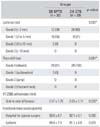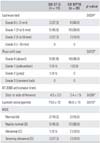1. Stewart DR, Burden SB. Does generalised ligamentous laxity increase seasonal incidence of injuries in male first division club rugby players? Br J Sports Med. 2004. 38(4):457–460.

2. Acasuso Diaz M, Collantes Estevez E, Sanchez Guijo P. Joint hyperlaxity and musculoligamentous lesions: study of a population of homogeneous age, sex and physical exertion. Br J Rheumatol. 1993. 32(2):120–122.
3. Decoster LC, Bernier JN, Lindsay RH, Vailas JC. Generalized joint hypermobility and its relationship to injury patterns among NCAA lacrosse players. J Athl Train. 1999. 34(2):99–105.
4. Nicholas JA. Injuries to knee ligaments: relationship to looseness and tightness in football players. JAMA. 1970. 212(13):2236–2239.

5. Kim SJ, Chang JH, Kim TW, Jo SB, Oh KS. Anterior cruciate ligament reconstruction with use of a single or double-bundle technique in patients with generalized ligamentous laxity. J Bone Joint Surg Am. 2009. 91(2):257–262.

6. Kim SJ, Kim TE, Lee DH, Oh KS. Anterior cruciate ligament reconstruction in patients who have excessive joint laxity. J Bone Joint Surg Am. 2008. 90(4):735–741.

7. Myer GD, Ford KR, Paterno MV, Nick TG, Hewett TE. The effects of generalized joint laxity on risk of anterior cruciate ligament injury in young female athletes. Am J Sports Med. 2008. 36(6):1073–1080.

8. Ramesh R, Von Arx O, Azzopardi T, Schranz PJ. The risk of anterior cruciate ligament rupture with generalised joint laxity. J Bone Joint Surg Br. 2005. 87(6):800–803.

9. Griffin LY, Albohm MJ, Arendt EA, et al. Understanding and preventing noncontact anterior cruciate ligament injuries: a review of the Hunt Valley II meeting, January 2005. Am J Sports Med. 2006. 34(9):1512–1532.

10. Kramer LC, Denegar CR, Buckley WE, Hertel J. Factors associated with anterior cruciate ligament injury: history in female athletes. J Sports Med Phys Fitness. 2007. 47(4):446–454.
11. Soderman K, Alfredson H, Pietila T, Werner S. Risk factors for leg injuries in female soccer players: a prospective investigation during one out-door season. Knee Surg Sports Traumatol Arthrosc. 2001. 9(5):313–321.

12. Allen MK, Glasoe WM. Metrecom measurement of navicular drop in subjects with anterior cruciate ligament injury. J Athl Train. 2000. 35(4):403–406.
13. Loudon JK, Jenkins W, Loudon KL. The relationship between static posture and ACL injury in female athletes. J Orthop Sports Phys Ther. 1996. 24(2):91–97.

14. Smith J, Szczerba JE, Arnold BL, Perrin DH, Martin DE. Role of hyperpronation as a possible risk factor for anterior cruciate ligament injuries. J Athl Train. 1997. 32(1):25–28.
15. Woodford-Rogers B, Cyphert L, Denegar CR. Risk factors for anterior cruciate ligament injury in high school and college athletes. J Athl Train. 1994. 29(4):343–346.
16. Hardin JA, Voight ML, Blackburn TA, Canner GC, Soffer SR. The effects of "decelerated" rehabilitation following anterior cruciate ligament reconstruction on a hyperelastic female adolescent: a case study. J Orthop Sports Phys Ther. 1997. 26(1):29–34.

17. Alford JW, Bach BR Jr. Scott WN, editor. Instrumented ligamentous laxity testing. Surgery of the knee. 2006. 4th ed. Philadelphia: Churchill Livingstone/Elsevier;584–614.
18. Pearsall AW, Kovaleski JE, Heitman RJ, Gurchiek LR, Hollis JM. The relationships between instrumented measurements of ankle and knee ligamentous laxity and generalized joint laxity. J Sports Med Phys Fitness. 2006. 46(1):104–110.
19. Carter C, Wilkinson J. Persistent joint laxity and congenital dislocation of the hip. J Bone Joint Surg Br. 1964. 46(1):40–45.
20. Beighton P, Horan F. Orthopaedic aspects of the Ehlers-Danlos syndrome. J Bone Joint Surg Br. 1969. 51(3):444–453.
21. Beighton P, Solomon L, Soskolne CL. Articular mobility in an African population. Ann Rheum Dis. 1973. 32(5):413–418.
22. Rotes-Querol J. Articular laxity considered as factor of changes of the locomotor apparatus. Rev Rhum Mal Osteoartic. 1957. 24(7-8):535–539.
23. Boyle KL, Witt P, Riegger-Krugh C. Intrarater and interrater reliability of the Beighton and Horan Joint Mobility Index. J Athl Train. 2003. 38(4):281–285.
24. Bulbena A, Duro JC, Porta M, Faus S, Vallescar R, Martin-Santos R. Clinical assessment of hypermobility of joints: assembling criteria. J Rheumatol. 1992. 19(1):115–122.
25. Juul-Kristensen B, Rogind H, Jensen DV, Remvig L. Interexaminer reproducibility of tests and criteria for generalized joint hypermobility and benign joint hypermobility syndrome. Rheumatology (Oxford). 2007. 46(12):1835–1841.
26. Mikkelsson M, Salminen JJ, Kautiainen H. Joint hypermobility is not a contributing factor to musculoskeletal pain in pre-adolescents. J Rheumatol. 1996. 23(11):1963–1967.
27. El-Garf AK, Mahmoud GA, Mahgoub EH. Hypermobility among Egyptian children: prevalence and features. J Rheumatol. 1998. 25(5):1003–1005.
28. Gedalia A, Press J. Articular symptoms in hypermobile schoolchildren: a prospective study. J Pediatr. 1991. 119(6):944–946.

29. Kirk JA, Ansell BM, Bywaters EG. The hypermobility syndrome: musculoskeletal complaints associated with generalized joint hypermobility. Ann Rheum Dis. 1967. 26(5):419–425.

30. Larsson LG, Baum J, Mudholkar GS, Srivastava DK. Hypermobility: prevalence and features in a Swedish population. Br J Rheumatol. 1993. 32(2):116–119.

31. Jansson A, Saartok T, Werner S, Renstrom P. General joint laxity in 1845 Swedish school children of different ages: age- and gender-specific distributions. Acta Paediatr. 2004. 93(9):1202–1206.

32. Larsson LG, Baum J, Mudholkar GS. Hypermobility: features and differential incidence between the sexes. Arthritis Rheum. 1987. 30(12):1426–1430.

33. Quatman CE, Ford KR, Myer GD, Paterno MV, Hewett TE. The effects of gender and pubertal status on generalized joint laxity in young athletes. J Sci Med Sport. 2008. 11(3):257–263.

34. Seckin U, Tur BS, Yilmaz O, Yagci I, Bodur H, Arasil T. The prevalence of joint hypermobility among high school students. Rheumatol Int. 2005. 25(4):260–263.

35. Cheng JC, Chan PS, Hui PW. Joint laxity in children. J Pediatr Orthop. 1991. 11(6):752–756.

36. Seow CC, Chow PK, Khong KS. A study of joint mobility in a normal population. Ann Acad Med Singapore. 1999. 28(2):231–236.
37. Birrell FN, Adebajo AO, Hazleman BL, Silman AJ. High prevalence of joint laxity in West Africans. Br J Rheumatol. 1994. 33(1):56–59.

38. Klemp P, Williams SM, Stansfield SA. Articular mobility in Maori and European New Zealanders. Rheumatology (Oxford). 2002. 41(5):554–557.

39. McCormack M, Briggs J, Hakim A, Grahame R. Joint laxity and the benign joint hypermobility syndrome in student and professional ballet dancers. J Rheumatol. 2004. 31(1):173–178.
40. Al-Rawi ZS, Al-Aszawi AJ, Al-Chalabi T. Joint mobility among university students in Iraq. Br J Rheumatol. 1985. 24(4):326–331.

41. Jessee EF, Owen DS Jr, Sagar KB. The benign hypermobile joint syndrome. Arthritis Rheum. 1980. 23(9):1053–1056.

42. Boden BP, Dean GS, Feagin JA Jr, Garrett WE Jr. Mechanisms of anterior cruciate ligament injury. Orthopedics. 2000. 23(6):573–578.

43. Griffin LY, Agel J, Albohm MJ, et al. Noncontact anterior cruciate ligament injuries: risk factors and prevention strategies. J Am Acad Orthop Surg. 2000. 8(3):141–150.

44. Ireland ML. The female ACL: why is it more prone to Injury? Orthop Clin North Am. 2002. 33(4):637–651.

45. Ostenberg A, Roos H. Injury risk factors in female European football: a prospective study of 123 players during one season. Scand J Med Sci Sports. 2000. 10(5):279–285.

46. Uhorchak JM, Scoville CR, Williams GN, Arciero RA, St Pierre P, Taylor DC. Risk factors associated with noncontact injury of the anterior cruciate ligament: a prospective four-year evaluation of 859 West Point cadets. Am J Sports Med. 2003. 31(6):831–842.

47. Harner CD, Paulos LE, Greenwald AE, Rosenberg TD, Cooley VC. Detailed analysis of patients with bilateral anterior cruciate ligament injuries. Am J Sports Med. 1994. 22(1):37–43.

48. Loudon JK, Goist HL, Loudon KL. Genu recurvatum syndrome. J Orthop Sports Phys Ther. 1998. 27(5):361–367.

49. Beckett ME, Massie DL, Bowers KD, Stoll DA. Incidence of hyperpronation in the ACL injured knee: a clinical perspective. J Athl Train. 1992. 27(1):58–62.
50. El O, Akcali O, Kosay C, et al. Flexible flatfoot and related factors in primary school children: a report of a screening study. Rheumatol Int. 2006. 26(11):1050–1053.

51. Rao UB, Joseph B. The influence of footwear on the prevalence of flat foot: a survey of 2300 children. J Bone Joint Surg Br. 1992. 74(4):525–527.

52. Sachithanandam V, Joseph B. The influence of footwear on the prevalence of flat foot: a survey of 1846 skeletally mature persons. J Bone Joint Surg Br. 1995. 77(2):254–257.

53. Kim SJ, Jung KA, Song DH. Arthroscopic double-bundle anterior cruciate ligament reconstruction using autogenous quadriceps tendon. Arthroscopy. 2006. 22(7):797.e1–797.e5.

54. Kim SJ, Kumar P, Oh KS. Anterior cruciate ligament reconstruction: autogenous quadriceps tendon-bone compared with bone-patellar tendon-bone grafts at 2-year follow-up. Arthroscopy. 2009. 25(2):137–144.

55. Jackson DW, Simon TM. Donor cell survival and repopulation after intraarticular transplantation of tendon and ligament allografts. Microsc Res Tech. 2002. 58(1):25–33.

56. Victor J, Bellemans J, Witvrouw E, Govaers K, Fabry G. Graft selection in anterior cruciate ligament reconstruction-prospective analysis of patellar tendon autografts compared with allografts. Int Orthop. 1997. 21(2):93–97.

57. Beynnon BD, Johnson RJ, Fleming BC, et al. Anterior cruciate ligament replacement: comparison of bone-patellar tendon-bone grafts with two-strand hamstring grafts: a prospective, randomized study. J Bone Joint Surg Am. 2002. 84(9):1503–1513.

58. O'Neill DB. Arthroscopically assisted reconstruction of the anterior cruciate ligament: a prospective randomized analysis of three techniques. J Bone Joint Surg Am. 1996. 78(6):803–813.
59. Otero AL, Hutcheson L. A comparison of the doubled semitendinosus/gracilis and central third of the patellar tendon autografts in arthroscopic anterior cruciate ligament reconstruction. Arthroscopy. 1993. 9(2):143–148.

60. Aune AK, Holm I, Risberg MA, Jensen HK, Steen H. Four-strand hamstring tendon autograft compared with patellar tendon-bone autograft for anterior cruciate ligament reconstruction: a randomized study with two-year follow-up. Am J Sports Med. 2001. 29(6):722–728.

61. Eriksson K, Anderberg P, Hamberg P, et al. A comparison of quadruple semitendinosus and patellar tendon grafts in reconstruction of the anterior cruciate ligament. J Bone Joint Surg Br. 2001. 83(3):348–354.

62. Shaieb MD, Kan DM, Chang SK, Marumoto JM, Richardson AB. A prospective randomized comparison of patellar tendon versus semitendinosus and gracilis tendon autografts for anterior cruciate ligament reconstruction. Am J Sports Med. 2002. 30(2):214–220.

63. Gobbi A, Domzalski M, Pascual J. Comparison of anterior cruciate ligament reconstruction in male and female athletes using the patellar tendon and hamstring autografts. Knee Surg Sports Traumatol Arthrosc. 2004. 12(6):534–539.

64. Noojin FK, Barrett GR, Hartzog CW, Nash CR. Clinical comparison of intraarticular anterior cruciate ligament reconstruction using autogenous semitendinosus and gracilis tendons in men versus women. Am J Sports Med. 2000. 28(6):783–789.

65. Kim SJ, Moon HK, Kim SG, Chun YM, Oh KS. Does severity or specific joint laxity influence clinical outcomes of anterior cruciate ligament reconstruction? Clin Orthop Relat Res. 2010. 468(4):1136–1141.

66. Jagodzinski M, Richter GM, Passler HH. Biomechanical analysis of knee hyperextension and of the impingement of the anterior cruciate ligament: a cinematographic MRI study with impact on tibial tunnel positioning in anterior cruciate ligament reconstruction. Knee Surg Sports Traumatol Arthrosc. 2000. 8(1):11–19.

67. Nishimori M, Sumen Y, Sakaridani K, Nakamura M. An evaluation of reconstructed ACL impingement on PCL using MRI. Magn Reson Imaging. 2007. 25(5):722–726.

68. Arneja S, Froese W, MacDonald P. Augmentation of femoral fixation in hamstring anterior cruciate ligament re construction with a bioabsorbable bead: a prospective single-blind randomized clinical trial. Am J Sports Med. 2004. 32(1):159–163.

69. Beynnon BD, Johnson RJ, Fleming BC. The science of anterior cruciate ligament rehabilitation. Clin Orthop Relat Res. 2002. (402):9–20.

70. Kim SJ, Kim HK, Lee YT. Arthroscopic anterior cruciate ligament reconstruction using autogenous hamstring tendon graft without detachment of the tibial insertion. Arthroscopy. 1997. 13(5):656–660.

71. Kim SJ, Jo SB, Kim TW, Chang JH, Choi HS, Oh KS. A modified arthroscopic anterior cruciate ligament double-bundle reconstruction technique with autogenous quadriceps tendon graft: remnant-preserving technique. Arch Orthop Trauma Surg. 2009. 129(3):403–407.








 PDF
PDF ePub
ePub Citation
Citation Print
Print




 XML Download
XML Download